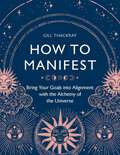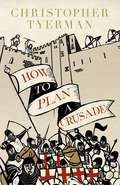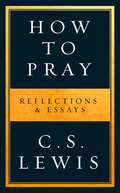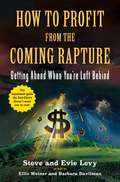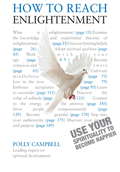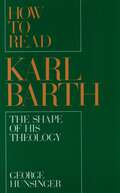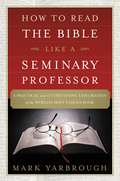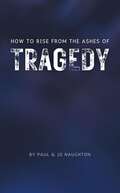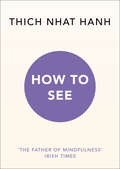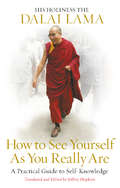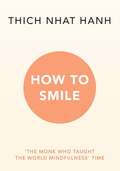- Table View
- List View
How to Manifest: Bring Your Goals into Alignment with the Alchemy of the Universe
by Gill ThackrayDo you have dreams that inspire you? And goals that you haven’t achieved but don’t know why? Are you feeling blocked, lacking self-belief but ready to make a change to your mindset? Then manifesting is for you. Manifesting has been practised by ancient wisdom traditions around the world for thousands of years. When you manifest you begin to invite the law of attraction into your life. Gill Thackray, mindfulness teacher, coach and psychologist, brings together the essential tools you will need to make meaningful change in your life. Gill will guide you through the simple steps to help you discover your true self and to reach your potential. From setting your intention and creating your vision to developing your manifesting mindset and connecting with the universe, as well as learning the 369 method, finding your power animal, the importance of full moon rituals, balancing your chakras, cultivating gratitude and much more, this little book will show how to manifest your dreams and help you to live your life to the full. Whether you are looking for a career change, to find love, peace or happiness, How to Manifest is the secret to your success.
How to Pick a Religion: How To Pick A Religion (Teach Yourself)
by Trevor BarnesThis book is organized as a thematic consumer guide to religion, looking at the benefits (and costs) of different world religions from the viewpoint of the believer. Whether you're interested in money, sex and power, or art, science, and relaxation, How To Pick A Religion will help you identify the religion that is right for you.
How to Plan a Crusade: Reason and Religious War in the High Middle Ages
by Christopher Tyerman'Wonderfully written and characteristically brilliant' Peter Frankopan, author of The Silk Roads'Elegant, readable ... an impressive synthesis ... Not many historians could have done it' - Jonathan Sumption, Spectator'Tyerman's book is fascinating not just for what it has to tell us about the Crusades, but for the mirror it holds up to today's religious extremism' - Tom Holland, SpectatorThousands left their homelands in the Middle Ages to fight wars abroad. But how did the Crusades actually happen? From recruitment propaganda to raising money, ships to siege engines, medicine to the power of prayer, this vivid, surprising history shows holy war - and medieval society - in a new light.
How To Practise: The Way to a Meaningful Life
by Dalai LamaHow To Practise is a major inspirational work, by one of the world's greatest spiritual teachers. It is broken down into the basic steps to enlightenment: how to practise morality, how to practise meditation, and how to practise wisdom - at the same time, delving deeper into His Holiness' more general Buddhist teachings, his spirit, wisdom and sense of humour. The book, meant to be used as part of daily practice, is easy to understand and filled with anecdotes. It includes guidance on mental calm, altruism and compassion, refraining from harm, focussing the mind, and much more.Beautifully packaged, this is the ultimate gift from the Dalai Lama, and a wonderful gift to give to anyone interested in having a richer, more fulfilled life.
How to Pray: A Simple Guide for Normal People
by Pete GreigEveryone prays. But no one finds it easy.We all need a little help. Pete Greig has been teaching on prayer - and leading a non-stop prayer movement - for twenty years. Now, for the first time, he puts his life's work into a response to the question everybody ultimately asks: how do I pray? This down-to-earth introduction to life's greatest adventure will guide you deeper in your relationship with God, helping you to become more centred and still, clearer in discerning God's voice, more able to make sense of your disappointments and more expectant for miraculous breakthroughs too. It's full of honest, hard-won wisdom interspersed with real-life stories - some humorous, others moving - to equip and inspire your prayer life. Journeying through the Lord's Prayer, and accompanied by online videos from The Prayer Course, which has been used by more than a million people, it unpacks nine essential aspects of prayer: stillness, adoration, petition, intercession, perseverance, contemplation, listening, confession and spiritual authority. From one of today's most visionary communicators, for those who've been praying for years as well as those who want to pray but don't know where to begin, How to Pray is the simple, life-changing guide you've been waiting for.
How to Pray: Reflections And Essays
by C. S. LewisC. S. Lewis here offers wisdom and lessons that illuminate our private dialogue with God—prayer—in this collection drawn from the breadth of his writings.
How to Profit From the Coming Rapture: Getting Ahead When You're Left Behind
by Evie Levy Steve LevyAre the end times near? Is the Rapture really just around the corner? Could Jerry Falwell and Pat Robertson possibly be right? About 1 billion people among us believe, yes, absolutely. And that means one thing: investment opportunities! For those who are not as expertly versed in the Book of Revelation, Ellis Weiner and Barbara Davilman, authors of the bestselling Yiddish with Dick and Jane, helpfully offer both illumination and advice: What exactly is the Rapture, anyway? How is it different from the Tribulation? Who are the Antichrist, the Four Horsemen, and the 144,000 male virgins, and what do they want? And, most important, how can I make money during the 7 years of societal breakdown before Armaggedon? Taking the familiar form of a how-to investment guide, How to Profit From the Coming Rapture instructs those readers who will certainly be left behind (Jews, Catholics, Muslims, Buddhists, Hindus, less ardent Protestants, and many more) on how to exploit the inevitable demise of the world in order to make a tidy profit. Sure, the rivers and seas will run with blood, locusts will swarm, mountains will move all over the place, and famine will strike. But for the five billion of us left behind, the post-Rapture world will be a time of even more unique investment opportunities.
How to Reach Enlightenment: Use Your Spirituality to Become Happier (Teach Yourself)
by Polly CampbellHow to Reach Enlightenment offers practical strategies for those who are struggling to find an enlightened way of life, bringing straightforward self-help techniques to the world of spirituality. It shows you what enlightenment is before moving on to the various ways in which you can create a sense of awareness in your life. Covering everything from the basics of self-acceptance to meditation and mindfulness, each chapter contains a diagnostic test, case studies, practical exercises and Aide Memoire boxes. Chapters conclude with a reminder of the key points of the chapter (Focus Points) and a round-up of what to expect in the next (Next Step) will whet your appetite for what's coming and how it relates to what you've just read.
How to Read a Graveyard: Journeys in the Company of the Dead
by Peter StanfordDeath is the one certainty in life, yet, with the decline of religion in the West, we have become collectively reluctant to talk about it. Our contemporary rituals seek to sanitise death and distance us from our own inevitable fate. If we want to know how previous generations dealt with death, graveyards (famous and not) tell us the history -- if we are able to read them. If we want to know how we struggle today with understanding or facing up to death, then graveyards provide a starting point. And, if we want to escape the present taboo on acknowledging our mortality and contemplate our own end, then graveyards offer a rare welcome.From Neolithic mounds to internet memorials via medieval corpse roads and municipal cemeteries, war graves and holocaust memorials, Roman catacombs, Pharaonic grave-robbers, Hammer horrors, body-snatchers, Days of the Dead, humanist burials and flameless cremations, Stanford shows us how to read a graveyard, what to look out for in our own, and how even the most initially unpromising exploration can enthral.
How to Read a Graveyard: Journeys in the Company of the Dead
by Peter StanfordDeath is the one certainty in life, yet, with the decline of religion in the West, we have become collectively reluctant to talk about it. Our contemporary rituals seek to sanitise death and distance us from our own inevitable fate. If we want to know how previous generations dealt with death, graveyards (famous and not) tell us the history -- if we are able to read them. If we want to know how we struggle today with understanding or facing up to death, then graveyards provide a starting point. And, if we want to escape the present taboo on acknowledging our mortality and contemplate our own end, then graveyards offer a rare welcome.From Neolithic mounds to internet memorials via medieval corpse roads and municipal cemeteries, war graves and holocaust memorials, Roman catacombs, Pharaonic grave-robbers, Hammer horrors, body-snatchers, Days of the Dead, humanist burials and flameless cremations, Stanford shows us how to read a graveyard, what to look out for in our own, and how even the most initially unpromising exploration can enthral.This enhanced edition includes suggestions of over 40 graveyards and cemeteries to visit in the UK and beyond, a photographic tour of Saint Margaret's Cemetery, Burnham Norton and an audio tour by the author of Paddington Old Cemetery, London.
How to Read Karl Barth: The Shape of His Theology
by George HunsingerThis critical study decodes the most cryptic and elusive patterns of Karl Barth's dialectic. Hunsinger not only offers a new and authoritative interpretation of Barth's mature theology, but also places Barth's work in relation to contemporary discussions of truth, justified belief, double agency, and religious pluralism. Through a fresh and compelling reading of Church Dogmatics, Hunsinger offers a new account of the coherence of that work as a whole.
How to Read the Bible: History, Prophecy, Literature--Why Modern Readers Need to Know the Difference and What It Means for Faith Today
by Steven L McKenzieMcKenzie argues that to comprehend the Bible we must grasp the intentions of the biblical authors themselves--what sort of texts they thought they were writing and how they would have been understood by their intended audience. In short, we must recognize the genres to which these texts belong. McKenzie examines several genres that are typically misunderstood, offering careful readings of specific texts to show how the confusion arises, and how knowing the genre produces a correct reading. The book of Jonah, for example, offers many clues that it is meant as a humorous satire, not a straight-faced historical account of a man who was swallowed by a fish. Likewise, McKenzie explains that the very names "Adam" and "Eve" tell us that these are not historical characters, but figures who symbolize human origins ("Adam" means man , "Eve" is related to the word for life ). Similarly, the authors of apocalyptic texts--including the Book of Revelation--were writing allegories of events that were happening in their own time. Not for a moment could they imagine that centuries afterwards, readers would be poring over their works for clues to the date of the Second Coming of Christ, or when and how the world would end. For anyone who takes reading the Bible seriously and who wants to get it right, this book will be both heartening and enlightening.
How to Read the Bible: History, Prophecy, Literature--Why Modern Readers Need to Know the Difference and What It Means for Faith Today
by Steven L McKenzieMcKenzie argues that to comprehend the Bible we must grasp the intentions of the biblical authors themselves--what sort of texts they thought they were writing and how they would have been understood by their intended audience. In short, we must recognize the genres to which these texts belong. McKenzie examines several genres that are typically misunderstood, offering careful readings of specific texts to show how the confusion arises, and how knowing the genre produces a correct reading. The book of Jonah, for example, offers many clues that it is meant as a humorous satire, not a straight-faced historical account of a man who was swallowed by a fish. Likewise, McKenzie explains that the very names "Adam" and "Eve" tell us that these are not historical characters, but figures who symbolize human origins ("Adam" means man , "Eve" is related to the word for life ). Similarly, the authors of apocalyptic texts--including the Book of Revelation--were writing allegories of events that were happening in their own time. Not for a moment could they imagine that centuries afterwards, readers would be poring over their works for clues to the date of the Second Coming of Christ, or when and how the world would end. For anyone who takes reading the Bible seriously and who wants to get it right, this book will be both heartening and enlightening.
How to Read the Bible Like a Seminary Professor: A Practical and Entertaining Exploration of the World's Most Famous Book
by Mark YarbroughMany people admire and even revere the Bible, but they simply do not understand what they read, much less how to study Scripture. Yet they wish they could. In this insightful and alternately amusing guide, Professor Mark Yarbrough shows how easy and gratifying it is to unlock the hidden truths of God's Word and to discover a world where reading the Bible doesn't just satisfy our curiosity, but changes our life. To do this, the reader will step into the seminary classroom and observe the practical principles-the tricks of the trade-for becoming a more effective student of the Bible. But Yarbrough has made sure that his writing style and general approach will be appealing to both academic students and those involved in lay-level Bible study. Real life is whacky and in-your-face. Studying Scripture should be too.
How to Read the Bible Like a Seminary Professor: A Practical and Entertaining Exploration of the World's Most Famous Book
by Mark YarbroughMany people admire and even revere the Bible, but they simply do not understand what they read, much less how to study Scripture. Yet they wish they could. In this insightful and alternately amusing guide, Professor Mark Yarbrough shows how easy and gratifying it is to unlock the hidden truths of God's Word and to discover a world where reading the Bible doesn't just satisfy our curiosity, but changes our life. To do this, the reader will step into the seminary classroom and observe the practical principles-the tricks of the trade-for becoming a more effective student of the Bible. But Yarbrough has made sure that his writing style and general approach will be appealing to both academic students and those involved in lay-level Bible study. Real life is whacky and in-your-face. Studying Scripture should be too.
How to Relax (Mindfulness Essentials Ser.)
by Thich Nhat HanhHow to Relax is part of a new series of books from Zen Master, Thich Nhat Hanh, exploring the essential foundations of mindful meditation and practise. This book guides us in achieving deep relaxation, controlling stress, and renewing mental clarity. With sections on healing, relief from non-stop thinking, transforming unpleasant sounds, solitude, and more, How to Relax will help you achieve the benefits of relaxation no matter where you are.
How To Rise From The Ashes of Tragedy
by Paul Naughton Jo NaughtonWhen the storm clouds of life gather and you are engulfed with grief or surrounded by despair, you need grace to get through. As you read this book, faith will rise in your heart that you can survive catastrophe and come through even your darkest hour. You will receive a Word based perspective that will help you deal with devastation and recover. You will find out how to: * Receive healing and restoration * Encounter the love of God * Steer your way into new beginnings Part bible study, part testimony, this powerful book will help point you in the right direction; away from remorse, regret and sorrow and towards happiness, freedom and real joy.
How To Say Babylon: A Jamaican Memoir
by null Safiya SinclairSHORTLISTED FOR THE 2024 WOMEN'S PRIZE FOR NON-FICTION 'Vivid and empowering' GILLIAN ANDERSON 'A stunning book’ BERNARDINE EVARISTO ‘Dazzling’ TARA WESTOVER ‘A story about hope, imagination and resilience’ GUARDIAN An award-winning, inspiring memoir of family, education and resilience. Born in Montego Bay, Jamaica, where luxury hotels line pristine white sand beaches, Safiya Sinclair grew up guarding herself against an ever-present threat. Her father, a volatile reggae musician and strict believer in a militant sect of Rastafari, railed against Babylon, the corrupting influence of the immoral Western world just beyond their gate. To protect the purity of the women in their family he forbade almost everything. Her mother did what she could to bring joy to her children with books and poetry. But as Safiya’s imagination reached beyond its restrictive borders, her burgeoning independence brought with it ever greater clashes with her father. Soon she realised that if she was to live at all, she had to find some way to leave home. But how? How to Say Babylon is an unforgettable story of a young woman’s determination to live life on her own terms. A Guardian and Observer summer read. ‘I adored this book … Unforgettable’ ELIF SHAFAK ‘Electrifying’ OBSERVER ‘To read it is to believe that words can save’ MARLON JAMES ‘Breathless, scorching’ NEW YORK TIMES
How to See
by Thich Nhat HanhTruly see yourselfHow to See is about our misperceptions, how we can gain insight and how mindfulness practices can help us see our real selves. Thich Nhat Hanh brings his signature clarity, compassion and humour in showing us how to achieve an awakened, more relaxed state of self-awareness so we cn understand ourselves and the world around us. This is a perfect pocket-sized guide to life by the most renowned Zen master in the world, who was nominated for the Nobel Peace Prize.
How to See Yourself As You Really Are
by Dalai LamaFull of insights and very practical, this important book by the Dalai Lama shows that self-knowledge is the key to personal development and creating positive relationshipsHow to See Yourself As You Really Are is based on a fundamental Buddhist belief that love and insight work together to bring about enlightenment, like two wings of a bird. It provides a new perspective on the psychological problems of hurting ourselves through misguided, exaggerated notions of self, others, events and physical things. It shows how even our senses deceive us, drawing us into unwise attachments and negative actions that can only come back to haunt us in the future.Drawing on wisdom and techniques refined in Tibetan monasteries for more than a thousand years, and adopting as its structure traditional Buddhist steps of meditative reflection, How to See Yourself As You Really Are includes practical exercises and gives readers a clear path to assess their growth and personal development. The book is enlivened throughout with warm personal anecdotes and intimate accounts of the Dalai Lama's experiences as a life-long student, a meditator, a political leader and an international figure working with other Nobel Peace Laureates to address crises around the world.His Holiness the Dalai Lama is the spiritual leader of Tibet. Today, he lives in exile in Northern India and works tirelessly on behalf of the Tibetan people, as well as travelling the world to give spiritual teachings to sell-out audiences. He was awarded the Nobel Peace Prize in 1989.
How to Sit (Mindfulness Essentials Ser.)
by Thich Nhat HanhHow to Sit is part of a charming series of books from Zen Master, Thich Nhat Hanh, exploring the essential foundations of mindful meditation and practise.How to Sit provides explicit, simple directions on the mechanics of posture and breathing, along with instructions for how best to achieve an awakened, relaxed state of clarity to cultivate concentration and compassion.
How to Smile
by Thich Nhat Hanh'The monk who taught the world mindfulness' TimeOne breath, one step is all we need to feel at home and comfortable in the here and nowIn this enlightening series, world-renowned spiritual leader Thich Nhat Hanh shares the foundations of mindfulness practice and meditation.By applying considered breath and meditation, How to Smile acts as a guide to show us how to transform hurt into healing, while also allowing us to explore the strong emotions of anger, sadness, regret and fear.This is the essential guide to help you heal.
How to Spell Chanukah...And Other Holiday Dilemmas: 18 Writers Celebrate 8 Nights of Lights
by Emily FranklinRing in the holiday with eighteen writers who extol, excoriate, and expand our understanding of this most merry of Jewish festivals as they offer up funny, irreverent, and, yes, even nostalgic takes on a holiday that holds a special place in Jewish hearts . . . and stomachs.Pieces by Jonathan Tropper, Jennifer Gilmore, Steve Almond, Joanna Smith Rakoff, Adam Langer, and others address pressing issues: what is the weight gain associated with eating 432 latkes in eight nights? Offer joyous gratitude: “What a holiday! No pestilence, no slavery, no locusts, no cattle disease, or atonement. Thank God.” And afford tender truths: “You are reminded of your real gifts: a family you get to come home to.”Whether your family tradition included a Christmas tree or a Chanukah bush, whether the fights among your siblings rivaled the battles of the Maccabees, or even if you haven’t a clue who the Maccabees were, this little book illustrates the joys, frustrations, and small miracles of the season.
How to Study Global Christianity: A Short Guide for Students
by Jason BrunerThis book provides students with an accessible–yet critically oriented–introduction to the foundational methods and themes in Global Christianity scholarship over the past 40 years. While the field of Global Christianity is itself interdisciplinary, it largely has not reflected upon the various disciplines of which it is comprised. In addressing different methods that have constituted this field of scholarship, Jason Bruner draws students’ attention to the ways in which these elements have worked together, and what the implications for their use have been in the past and might be in the future. In addition to identifying themes within the discourse, this book offers a survey of where the field has been, what its analytical priorities are, and how future scholars might develop new research projects and trajectories in light of the its history.
How to Study Magic: A Guide to History, Lore, and Building Your Own Practice
by Sarah LyonsAn insider's guide for beginner mystics, How to Study Magic is your ultimate introduction to the main areas of magic—from witchcraft to grimoires—what it means to practice them, and, most of all, how to get started.Have you ever wanted to dive into the world of magic, but weren't sure where to begin? You're not alone! Knowing where to start can be mystifying, but it doesn't have to be. In How to Study Magic, author, educator, and seasoned witch Sarah Lyons guides you through an introductory course of study, and an enchanted entry point to the wide world of magical paths.Drawing on Sarah's own experience practicing and teaching magic for more than a decade, this interactive exploration takes novice witches through basic tools they can use in their studies—from divination and meditation to cleansing and protection—before diving into the history, lore, and modern incarnations of a wide range of magical practices. With chapters on Witchcraft, Chaos Magic, Spellbooks and Grimoires, Gods and Goddesses, and more, this dynamic guide gives readers an insider's perspective on how to craft their own, personalized practice. Each chapter also contains interactive activities, journal prompts, and suggestions for further reading, allowing baby witches to chart their own paths and explore their own power. For anyone who knows they want to study magic, but has no idea where to begin, How to Study Magic is the answer you've been waiting for.
